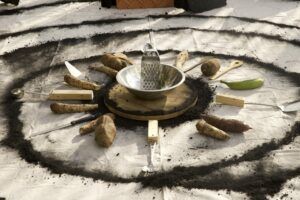To say remejunje:requemar begins or ends with a particular gesture would be misleading. Throughout the performance, Valeria activates and transforms roots. As Valeria navigates memory and legacy, she marks her present self and environment, nourishes the audience and herself, and builds material infrastructures that defy consumption.
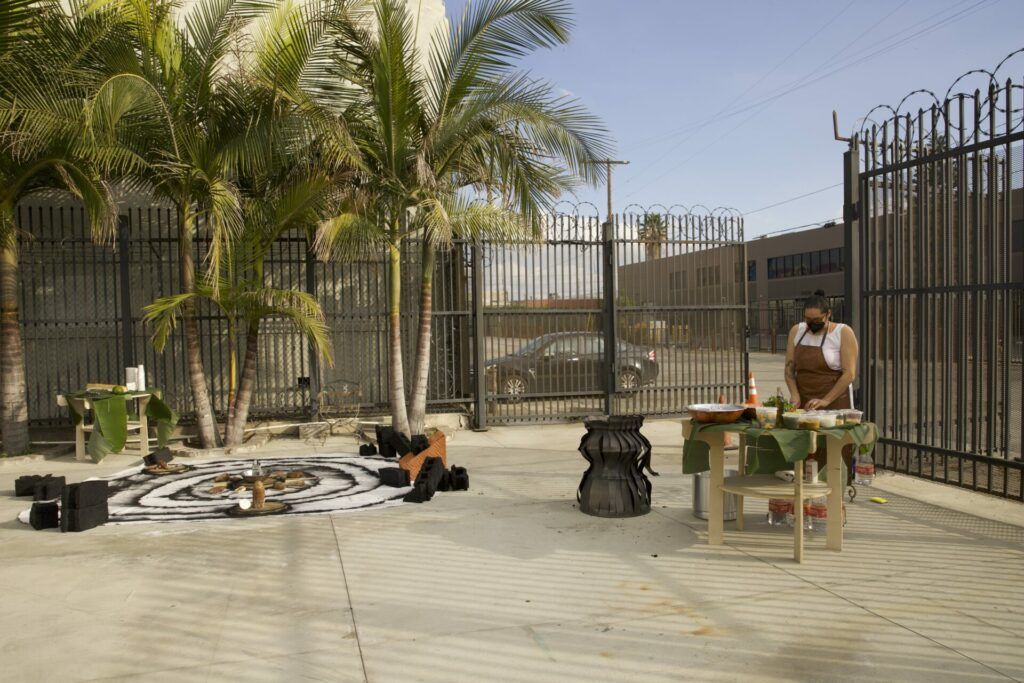
Music plays as Valeria loads pieces of her signature charcoal blocks into the body of a steel drum she designed into a stove. Across the stove from Valeria, the audience stands on the cement loading dock just outside the gallery doors, and we watch silently and intently as Valeria ignites the charcoal and tends the flames that heat the large pot placed atop the stove. While Valeria prepares ingredients on a hand-made circular wooden table covered with banana leaves, I take a wider look around to appreciate the scale and details of the world in which Valeria immerses us. The charcoal stove resembles the steel barrels used to cook street food in Puerto Rico but carries a twist: the stove’s form is an interpretation of the theory of special relativity, a representation of the relationship between space and time. The oil stains on Valeria’s dress and wrinkles on her apron signal past performances and mix with today’s event.
Eventually, the audience settles into the understanding that cooking sancocho from scratch takes time. As Valeria watches over and stirs the boiling pot of sancocho on the stove, audience members begin to mingle and take comfort in a seat on the cement ground, a cold Coco Rico from the cooler, and a piece of pan con aguacate. In waiting for Valeria to prepare and serve us food, we turn to entertain ourselves. Our bodies, voices, and energies interact in space, and we navigate the ebbs and flows of relating and belonging. From her position at the stove, Valeria facilitates a collective experience, transforming the role of the audience from passive observation to active social participation.
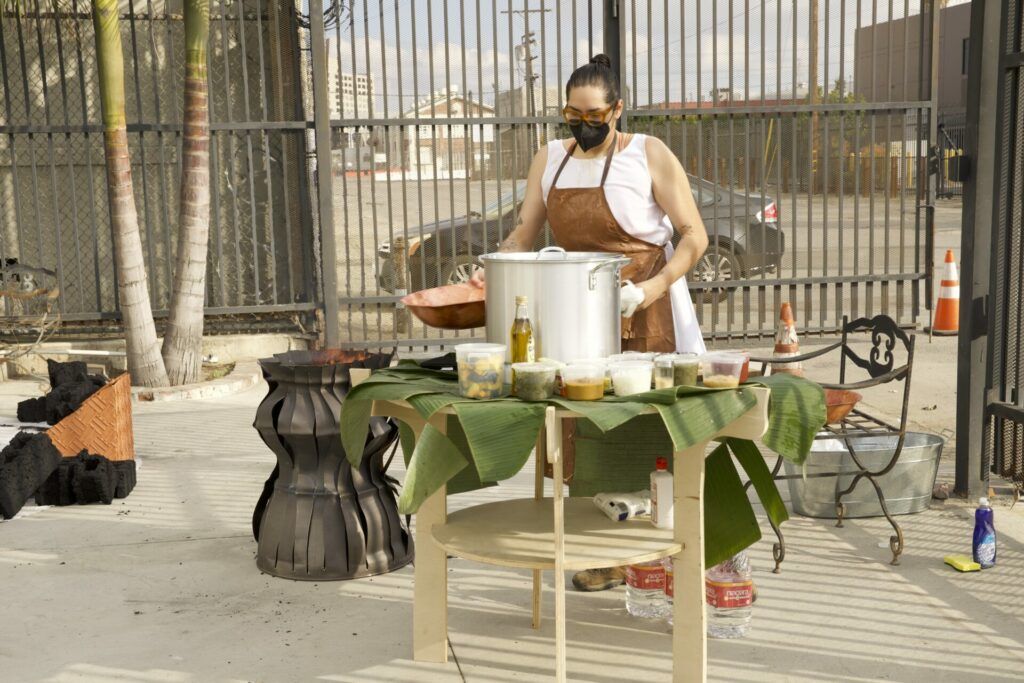
When the sancocho is ready, Valeria invites the audience to the stove where she serves us generous portions. While we enjoy sancocho in company, Valeria leaves the pot simmering on the stove, takes off her boots, and walks over to the zona de reflexión staged adjacent with a large circular canvas. On top of the canvas, concentric circles of charcoal dust extend from the center to the periphery, and three wooden cutting boards sit on different locations. Malanga, yuca, and yautía are each placed on a cutting board, alongside a respective cooking tool: peeler, knife, and grater. Next to the canvas are charcoal blocks and a ceramic cube structure representing dirt in architectural language.
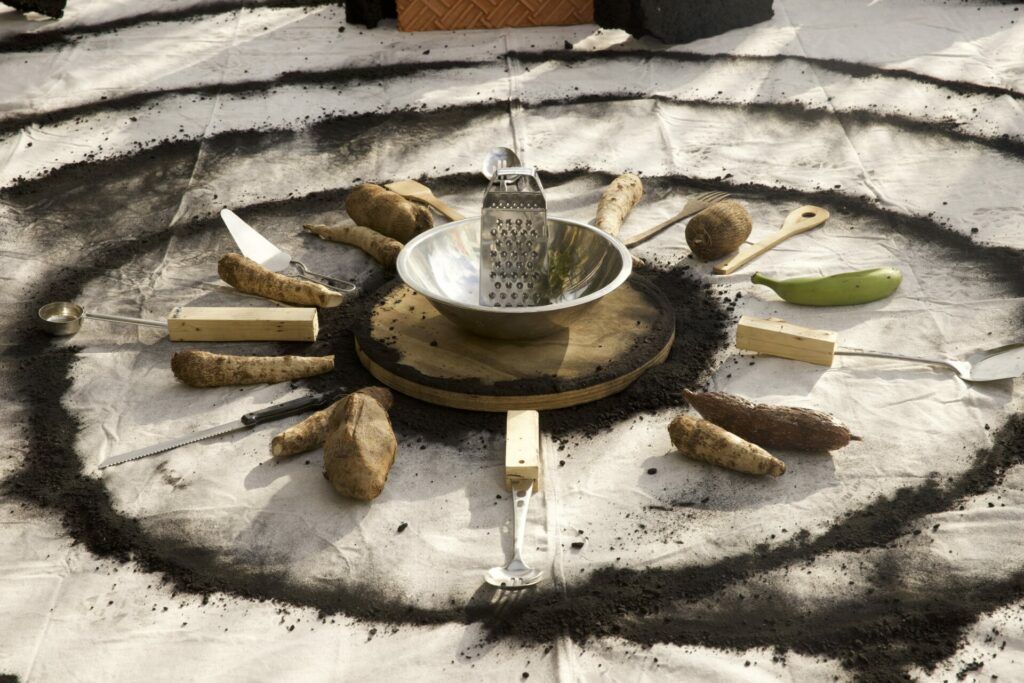
Image courtesy of Isabelle Abbitt.
A recording of Valeria’s mother, Doris, reciting the sancocho recipe plays while Valeria considers her approach to the outer circle of charcoal dust. Valeria walks carefully around the circular canvas then away from it as if to see it from a different vantage point. Valeria nears the circle again, and with her foot, she touches then clears an opening into the outer ring of charcoal dust. Valeria steps onto the outer ring, then takes a breath and stretches out before continuing to clear a path forward onto subsequent rings, which she brushes open with her feet and hands, covering her socks, skin, and the space between rings with charcoal dust. Before entering the final circle, Valeria steps all the way back outside of the circle then considers her reentry.
When Valeria retraces her steps into the circle and walks not towards the center but around the outer ring, where malanga is stationed alongside a peeler on a circular cutting board, I begin to consider how Valeria’s inward journey serves to engage process rather than arrive to center. Valeria clears the dust surrounding the cutting board, sits down, then picks up the peeler in one hand and the malanga in the other, transferring charcoal dust to both. Valeria places the peeler at the end of the root closest to her body and begins to forcefully peel out towards the end of the root. She stops suddenly, tells herself No, then reverses the direction of the peeling motion: starting from the end of the root furthest from her body, she peels in towards herself, continuing the motion until her fist, closed around the peeler, hits her chest. As Valeria corrects her technique and continues peeling the malanga from the outside in, I recall the recorded voice of her mother and imagine the sequence of connection, exchange, and transfer between generations of ancestors that Valeria embodies and reiterates through this gesture. I feel the tensions between a child’s impulse and a mother’s intervention, between oneself and tradition. Understanding that a parent or grandparent may teach a child the “right” or “safe” way to use a tool, including the body itself, I ask how we might reframe conformity and nonconformity as non-oppositional currents of adaptation. Sometimes, nonconformity is necessary for survival, not a threat to it; even when a ritual changes, it retains traces and memories of its history.
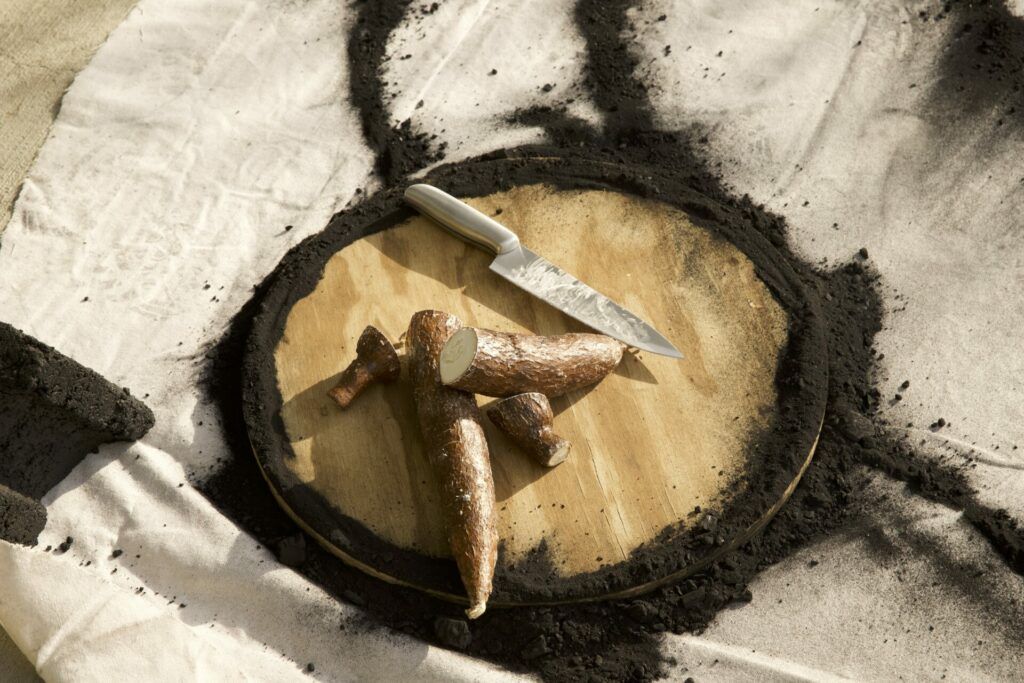
Image courtesy of Isabelle Abbitt.
Valeria places some of the peeled remains of malanga on the back of her hand, up her arm, and over her mouth before standing up and carving a path further into the circle and around to the yuca stationed alongside a large cooking knife. Valeria chops the yuca repeatedly into smaller chunks before running the blade along her leg, shaving hair from her legs, then her arms. Seeing Valeria prepare the roots then transpose cooking techniques onto her body, I consider the labor as well as the physical and emotional experience of negotiating gender norms imposed by family and internalized.
Valeria continues in and around the circle to the yautía stationed alongside a grater and empty bowl. Valeria shreds the yautía as well as the yuca and malanga, filling the bowl with a masa. When Valeria carries the bowl not into the center of the circle, but to the ceramic sculpture and blocks of charcoal between the canvas and the stove, I feel the heat of Valeria’s poetic turn. Using the ceramic sculpture as a base and the masa like mortar, Valeria assembles a vertical column of charcoal bricks, applying a layer of masa between each brick with a trowel. After wiping the excess masa from the assembled bricks with the trowel, she spreads the masa on her arms, cheeks, chin, forehead, and across her mouth. Valeria’s journey inwards and process of root preparation throughout the second act does not culminate in consumption, but in building and holding a structure together. Valeria charges her body with the task of binding together and carrying weight.
Finally, Tizol Vivas returns to the stove where she, covered in masa and charcoal dust, slips back into her boots and asks ¿Alguien quiere más?
Carlina: Not only is remejunje:requemar a circular performance in three acts, but you also enact the performance through a range of circular forms and gestures. Before you brush away the outer ring of charcoal dust, you take your time and contemplate your entrance. When you enter the circle, you move towards and through ancestral connections in order to build with this collective embodied experience. What’s happening internally as you approach and move inside the circle?
Valeria: A circle is a container of time, a cycle of time. I see history as a cycle. We perceive everything begins and ends at location, but there’s no true beginning or end. We’re part of an evolving cycle. A circle is also an orbit of relations. But a circle doesn’t have sides. It’s a very communal shape, a revolution through memory, acts of care, and healing.
I open the circle because I am ready to enter this space where I’m going to put my body through something. I have to decide that I want to be in. I go in when I feel ready to go in. Inside the circle, there’s another world. I put myself through the same process as the roots. I serve myself to others, put myself on the table. Seeing the circle from the outside gives me perspective that I’m reenacting, I’m doing an act. I’m not manifesting. I’m channeling. It’s a way for me to decide when I want to engage. I have power in the first interaction.
There’s something about taking control of when to act, acting when you’re ready, which is very different from acting out of necessity. Pressure is everywhere in Puerto Rico—it’s omnipresent. The rules of control are implanted into your being, based on your location and the power dynamics of society. The foundation of the colonial relationship is built on shame, guilt, and service. Pressure can make or break you—and then you learn to take control.
Inside the circle, I engage in a conversation through memory. I recreate the memories I had in the kitchen, experiences I was raised in and things that maternal figures told me. It’s not that I hear my grandmother, I react to my memory of her. I’m not hearing others, I’m hearing myself. I’m open. I’m talking to all the selves I have been that I have been taught to be. I’m able to decide in the moment the next step.
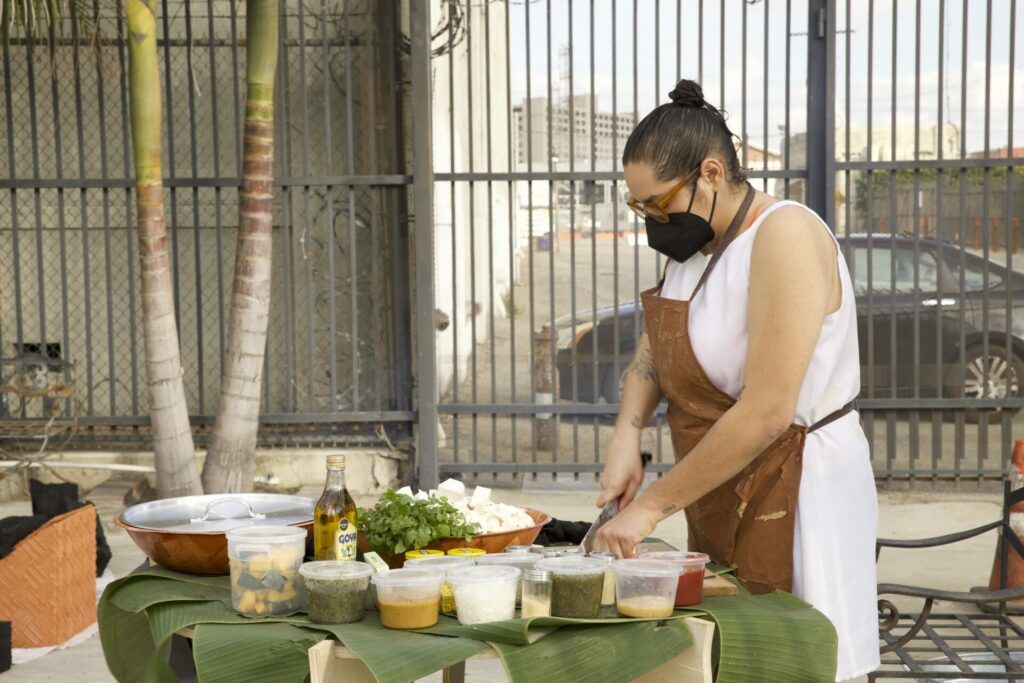
Image courtesy of Isabelle Abbitt.
Carlina: In remejunje:requemar, you use charcoal blocks to ignite the stove and assemble the vertical column, and you use charcoal dust to map a way to the roots as well as mark the roots and your body. Can you share more about the function of charcoal in your practice?
Valeria: Pyrolysis is the chemical process of making charcoal where the wood is put through high temperatures to remove oxygen. As a colonized islander, the process of making charcoal is anthropomorphized—I use the process to communicate how I feel, embodying not only myself, but all of the people connected to me. Charcoal has evolutionary importance as a material and a mark-making device—charcoal is a way for me to communicate in an ancient dialect. Charcoal also has the ability to absorb. The charcoal blocks used to create the column are containers of energy.
Carlina: Having first performed Mejunje in Puerto Rico for an audience that is familiar with sancocho, I’m curious to know more about how you adapted the performance for an audience in California that may have never tasted sancoho or heard of it before the performance.
Valeria: In Puerto Rico, the reactants (audience) had a different relationship to the performance—they didn’t need translation. I was communicating with them and our ancestors. There was a lineage of language, an ancient dialect of actions. In California, I had the opportunity to work with a Puerto Rican curator. I was in conversation with my ancestors—it was more personal and about survival as an artist in the diaspora. It became a gathering and a space to share the smells and recipe of my people. Also, I had a deeper understanding of process. Charcoal was not part of my first performance—I painted the masa on canvas with construction tools. In the future, I want to reenact the performance in Puerto Rico to continue the cycle and keep adding to the conversation.
Carlina: Of all the meals you could prepare for an audience, why sancocho?
Valeria: For me, sancocho is a stew that represents the mestizaje and resourcefulness of Caribbean and Latin American people, and it carries the ripples of colonization and the transatlantic slave trade. The stew morphs with the environment; its flavors and recipes evolve by adapting to the necessities of the region. It’s also made with what you have in hand. In a more personal way, it’s a connection to my Puerto Rican and Dominican lineage. I make sancocho with roots because I want to focus on what lies beneath us, the erased histories. I’m also interested in the cooking process. By slowly cooking starchy roots and vegetables in water, they dissolve into a velvety elixir of warmth—this is very different from how liquid immortalizes form when frying.
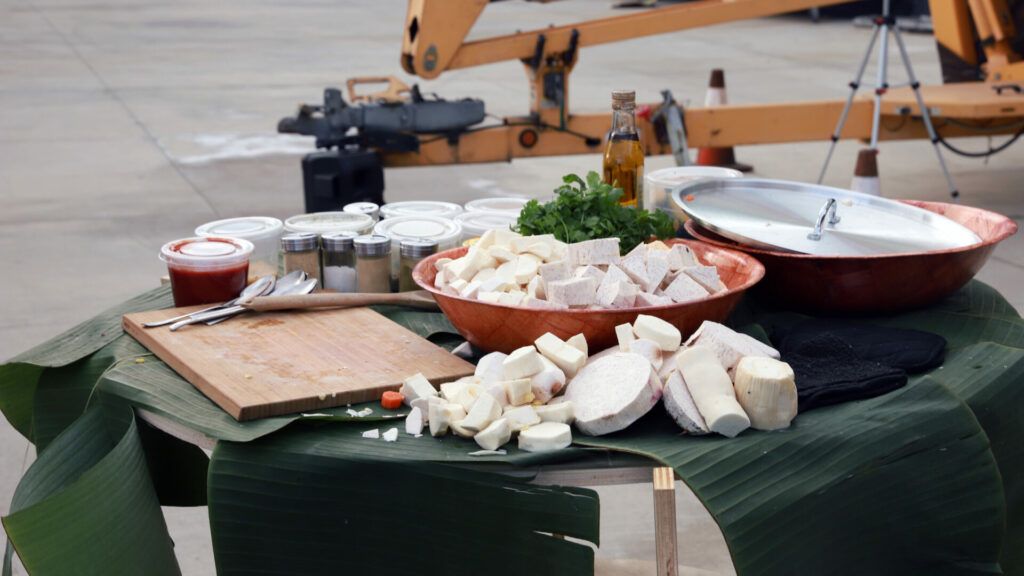
Image courtesy of Isabelle Abbitt.
